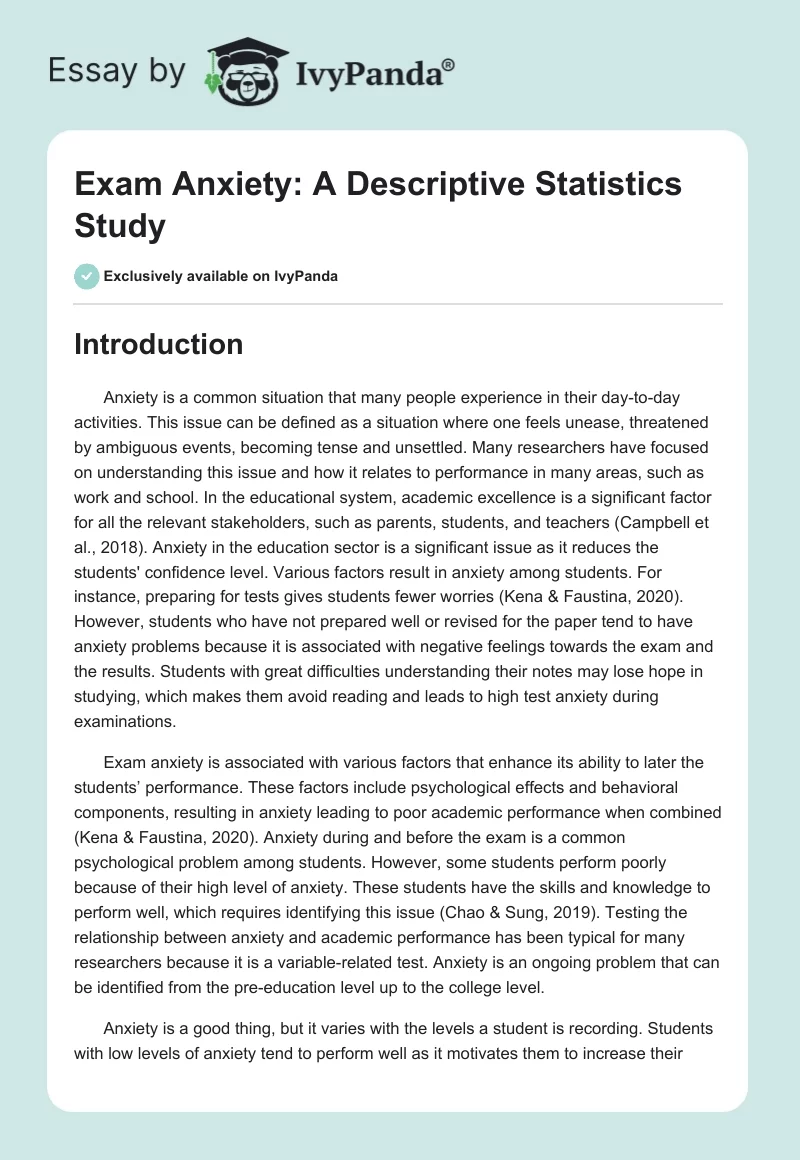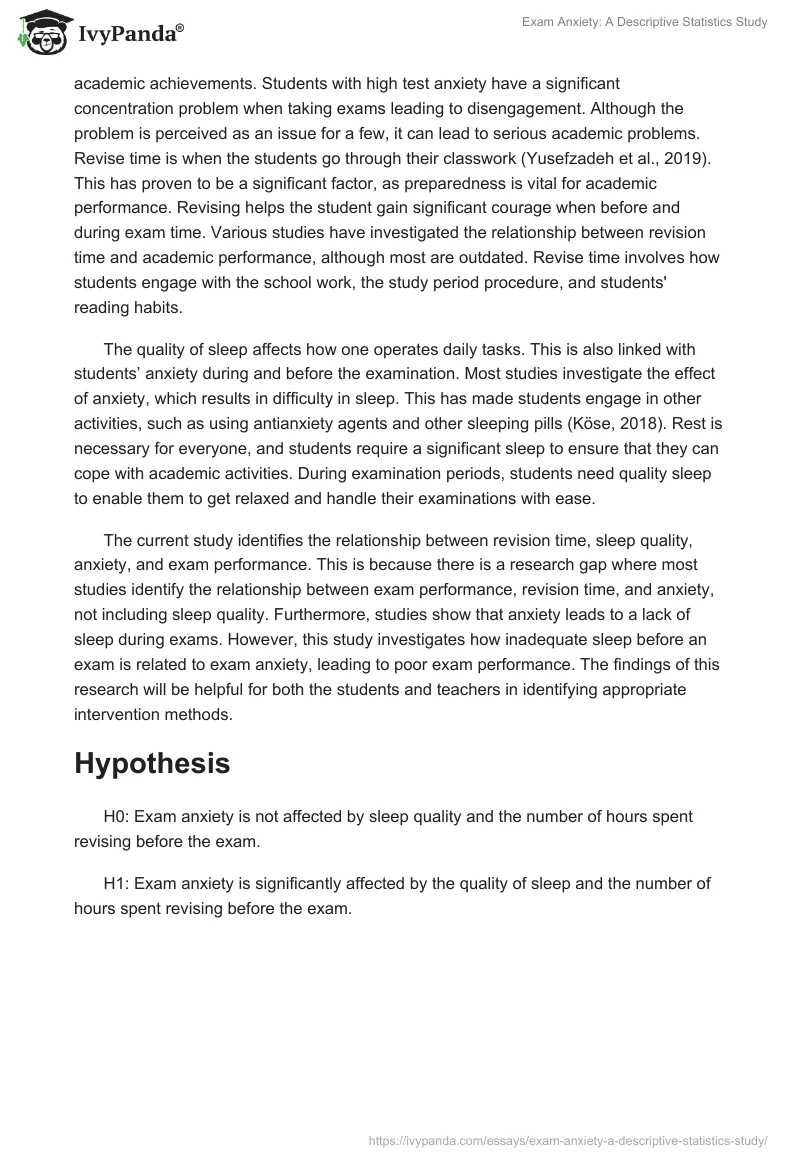Introduction
Anxiety is a common situation that many people experience in their day-to-day activities. This issue can be defined as a situation where one feels unease, threatened by ambiguous events, becoming tense and unsettled. Many researchers have focused on understanding this issue and how it relates to performance in many areas, such as work and school.
In the educational system, academic excellence is a significant factor for all the relevant stakeholders, such as parents, students, and teachers (Campbell et al., 2018). Anxiety in the education sector is a significant issue as it reduces the students’ confidence level. Various factors result in anxiety among students. For instance, preparing for tests gives students fewer worries (Kena & Faustina, 2020).
However, students who have not prepared well or revised for the paper tend to have anxiety problems because it is associated with negative feelings towards the exam and the results. Students with great difficulties understanding their notes may lose hope in studying, which makes them avoid reading and leads to high test anxiety during examinations.
Exam anxiety is associated with various factors that enhance its ability to later the students’ performance. These factors include psychological effects and behavioral components, resulting in anxiety leading to poor academic performance when combined (Kena & Faustina, 2020). Anxiety during and before the exam is a common psychological problem among students. However, some students perform poorly because of their high level of anxiety.
These students have the skills and knowledge to perform well, which requires identifying this issue (Chao & Sung, 2019). Testing the relationship between anxiety and academic performance has been typical for many researchers because it is a variable-related test. Anxiety is an ongoing problem that can be identified from the pre-education level up to the college level.
Anxiety is a good thing, but it varies with the levels a student is recording. Students with low levels of anxiety tend to perform well as it motivates them to increase their academic achievements. Students with high test anxiety have a significant concentration problem when taking exams leading to disengagement. Although the problem is perceived as an issue for a few, it can lead to serious academic problems. Revise time is when the students go through their classwork (Yusefzadeh et al., 2019). This has proven to be a significant factor, as preparedness is vital for academic performance.
Revising helps the student gain significant courage when before and during exam time. Various studies have investigated the relationship between revision time and academic performance, although most are outdated. Revise time involves how students engage with the school work, the study period procedure, and students’ reading habits.
The quality of sleep affects how one operates daily tasks. This is also linked with students’ anxiety during and before the examination. Most studies investigate the effect of anxiety, which results in difficulty in sleep. This has made students engage in other activities, such as using antianxiety agents and other sleeping pills (Köse, 2018). Rest is necessary for everyone, and students require a significant sleep to ensure that they can cope with academic activities. During examination periods, students need quality sleep to enable them to get relaxed and handle their examinations with ease.
The current study identifies the relationship between revision time, sleep quality, anxiety, and exam performance. This is because there is a research gap where most studies identify the relationship between exam performance, revision time, and anxiety, not including sleep quality. Furthermore, studies show that anxiety leads to a lack of sleep during exams. However, this study investigates how inadequate sleep before an exam is related to exam anxiety, leading to poor exam performance. The findings of this research will be helpful for both the students and teachers in identifying appropriate intervention methods.
Hypothesis
- H0: Exam anxiety is not affected by sleep quality and the number of hours spent revising before the exam.
- H1: Exam anxiety is significantly affected by the quality of sleep and the number of hours spent revising before the exam.
Material and Procedure
Material
The study utilized a questionnaire to collect data regarding time spent by students revising, the number of hours the student slept the night before the exam, sleep rating before the exam, and the amount of time spent revising a category. Demographic information such as gender, age, and age category was also recorded. The questionnaire assessed the quality and quantity of sleep because they are significant in determining the level of anxiety and students’ performance. The questionnaire used two forms of questions: closed and open-ended.
Procedure
The participants were recruited using various school social media groups where the current and active students were selected. The students were informed regarding the data collection process and that they would be required to participate in the survey at a given period. The students were informed that the survey would be conducted on Sunday or late Monday before the exams. The students were provided with a link to the survey brief to ensure that they were aware of the purpose and objectives of the current study and the instruction on how the survey will be conducted.
The researcher used text messages and emails to remind the students of the survey time and those who had not participated and were willing to participate in responding to the survey before its deadline. The participants were given distinct codes, which helped maintain their anonymity. The codes also ensure that no personal information is shared among the participants and keep the collected information confidential.
The survey questionnaire was organized into sections to allow the participants to respond easily to the questions. During the survey, the participants were required to click on the link provided, which was sent to them with unique codes to enable them to access the online questionnaire. After clicking the link, the students were taken to the first page of the research study, which allowed them to read the consent form provided, and all the participants were free to exit the survey at any point.
The study was conducted per the ethical consideration of the school of psychology, and since the participants were above the age of 18, they were required to fill out and sign the consent form. After completing the questionnaire, the submission button was displayed to enable the students to end the survey.
Results
Table 1:Descriptive statistics of the variables under study
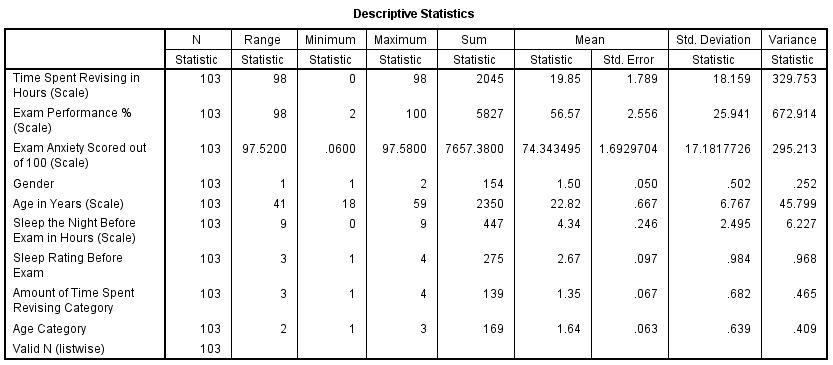
Table 2: Descriptive based for the males
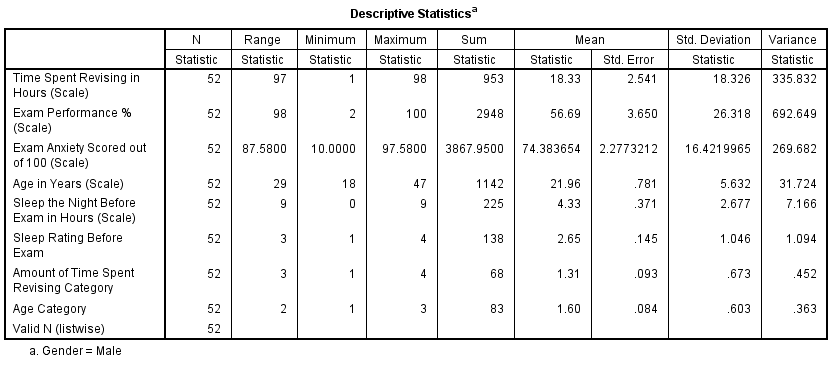
From table 1 above, the hour spent revising has a mean of 19.85 and a standard deviation of 18.159. The maximum hours spent revising is 98, and the minimum hour is 0. Exam performance has a mean of 56.57 and a standard deviation of 25.941. The maximum exam performance is 98, while the minimum is 2. Exam anxiety has a mean of 74.34 and a standard deviation of 17.181. The maximum exam anxiety score is 97.58, while the minimum is 0.06. The sleep hours before the exam has a mean of 4.34 and a standard deviation of 2.49.
Table 3: Descriptive for the females
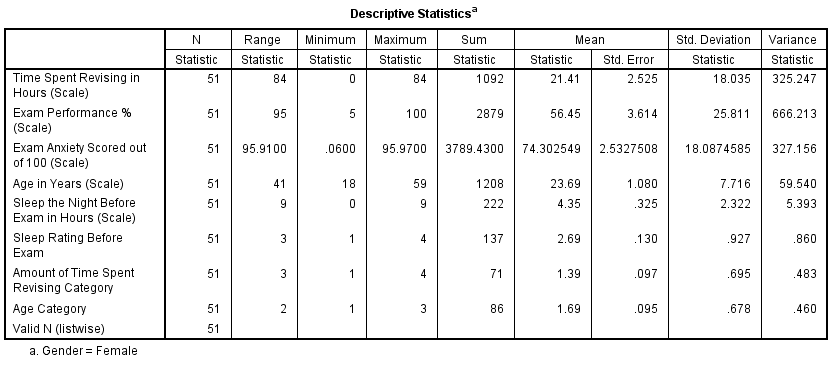
The maximum number of hours slept is nine while the minimum hours is 0. From table 2 and table 3 above, males have a higher average time spent in revising (M = 19.85, SD = 335.832) compared to females (M = 18.03, SD = 325.25). The females portray a higher exam performance (M = 56.69, SD = 26.31) than females (M = 56.45, SD = 25.81). However, females have a high average spent revising (M = 4.33, SD = 2.68) than males (M = 18.33, SD = 18.33). Males have a less average sleeping time before exam (M = 4.35, SD = 2.32) compared to females (M = 4.35, SD = 2.32).
Table 4:MANOVA results without interaction
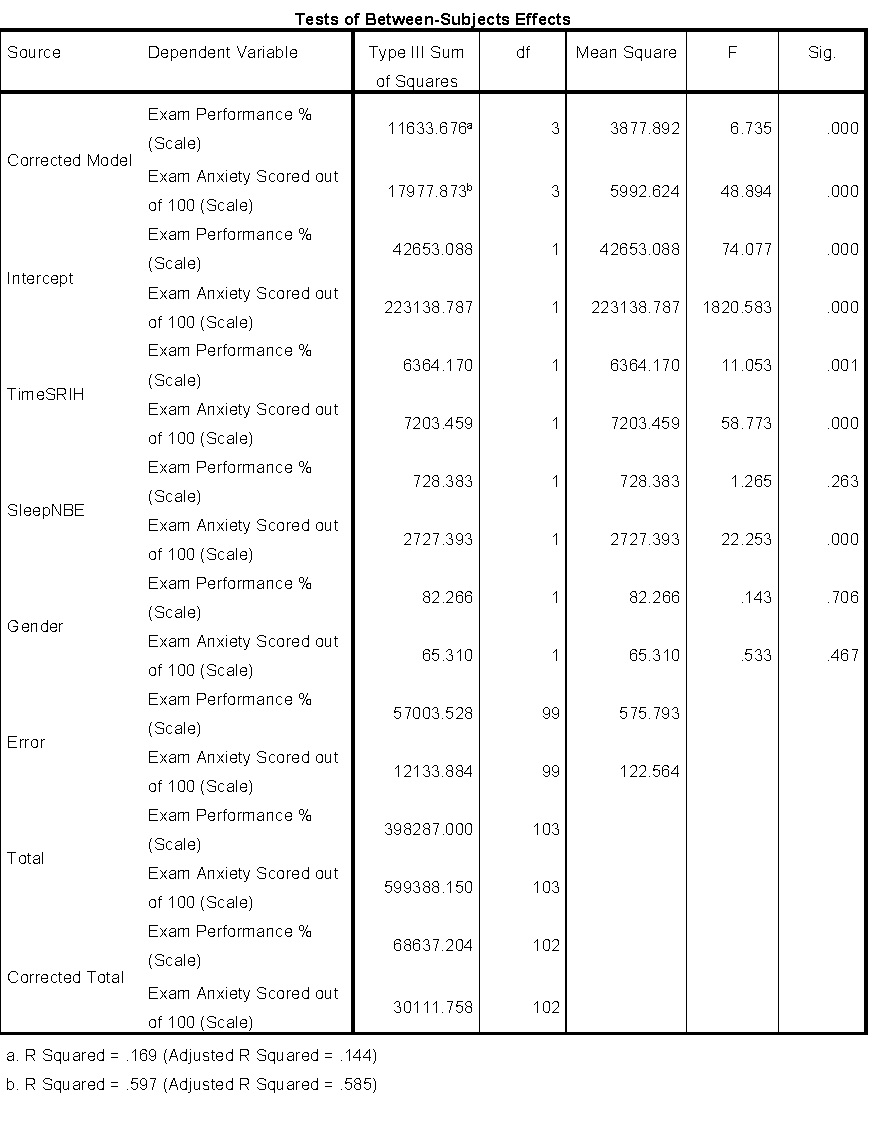
From table 4 above, the time spent in revising is significant for both dependent variables. Time spent revising and exam performance F (1, 103) = 11.053, p =0.01. Time spent revising and exam anxiety F (1, 102) = 58.773, p < 0.01. The p-value for time spent revising on exam performance is 0.01, while exam anxiety is less than 0.01. The number of hours slept the night before the exam and exam performance F (1, 103) = 1.65, p =0.263. The number of hours slept the night before the exam and exam anxiety F (1, 102) = 22.253, p <0.01. Gender and exam performance F (1, 103) = 0.143, p =0.706. Gender and exam anxiety F (1, 102) = 0.533, p =0.467. Gender is insignificant in determining exam performance and anxiety, as both p-values are greater than 0.05. The R-squared for exact statistics is 0.597, while the adjusted R-squared is 0.585.
Table 5: MANOVA test of time spent revising and sleep hours before the exam
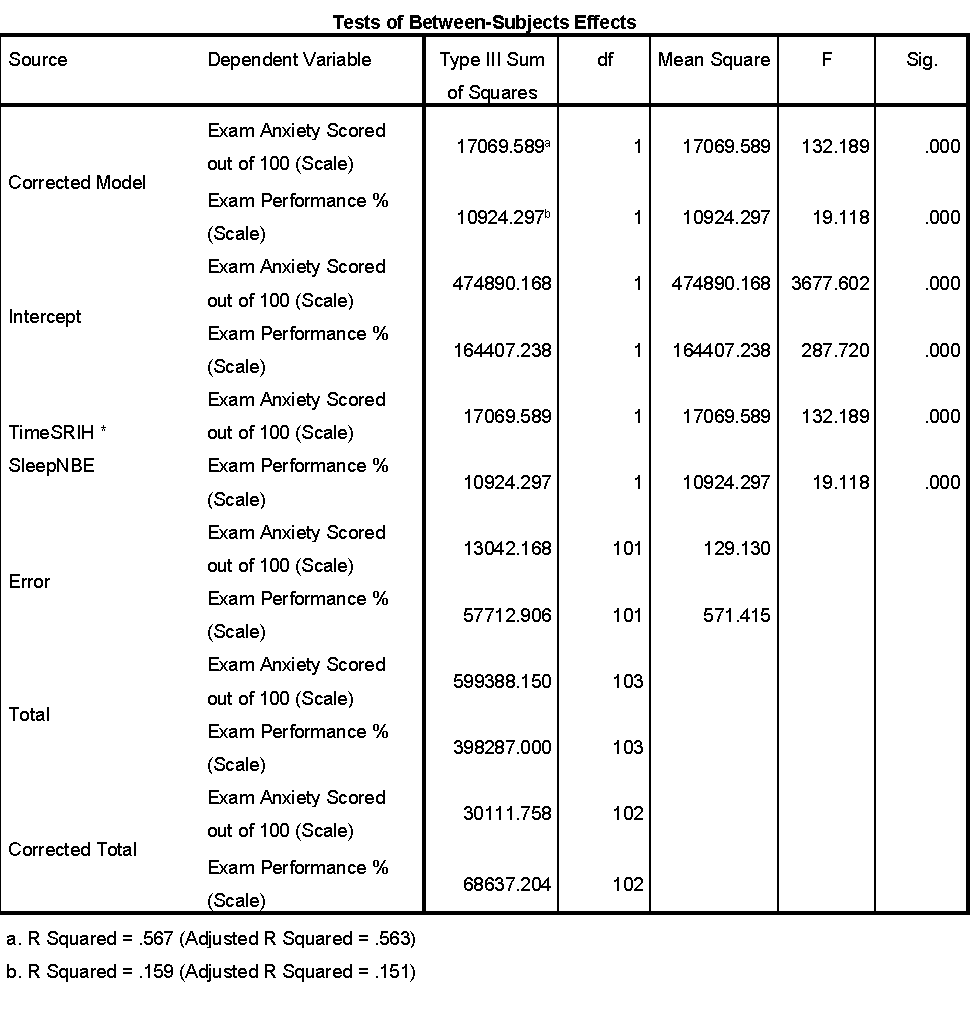
Table 5 shows that the interaction between time spent revising and the number of hours sleep before the exam is significant. Time spent revising and the number of slept interactions with exam performance F (1, 103) = 19.118, p <0.01. Time spent revising and the number of hours slept interaction design with exam anxiety F (1, 102) = 132.189, p <0.01.
Table 6:Independent sample t-test of exam anxiety between males and females
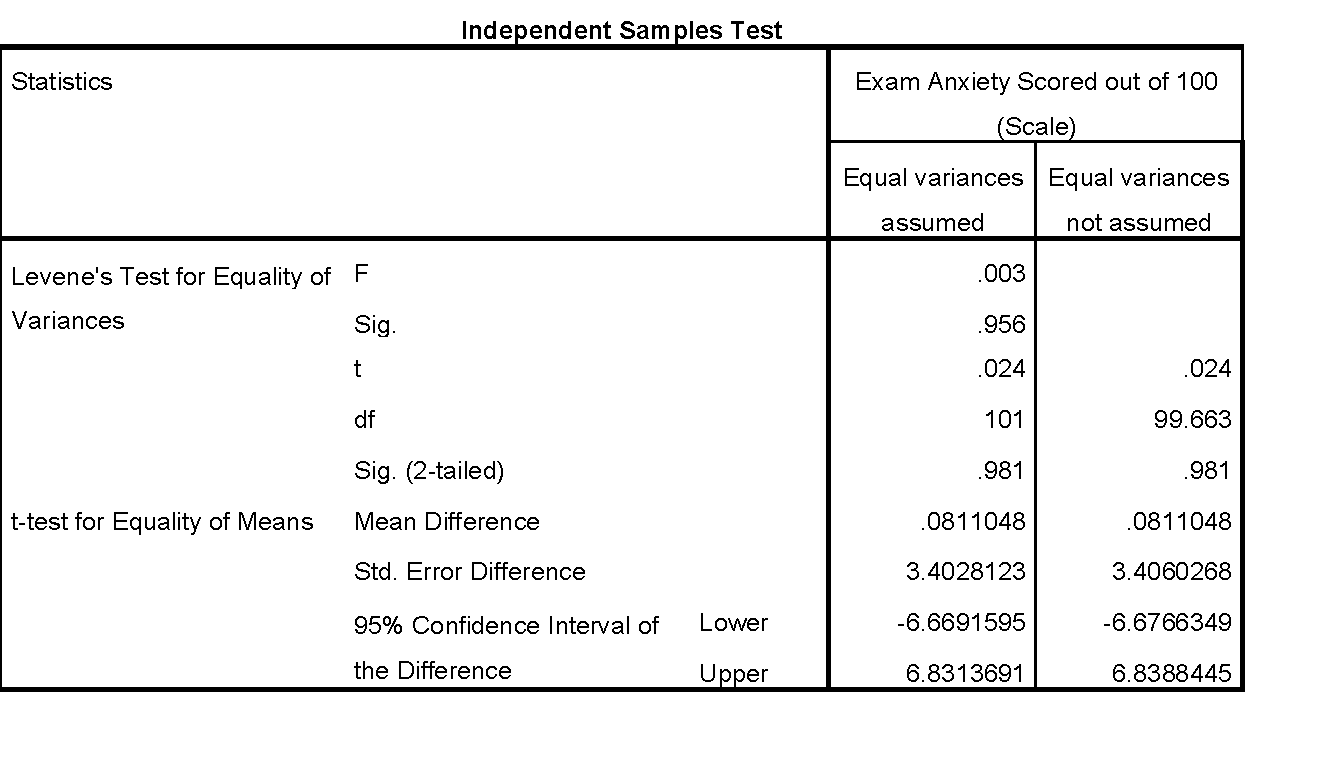
Table 6 above shows no significant difference between the anxiety level of males and females t (101) = 0.024, p = 0.981.
Table 7:Correlations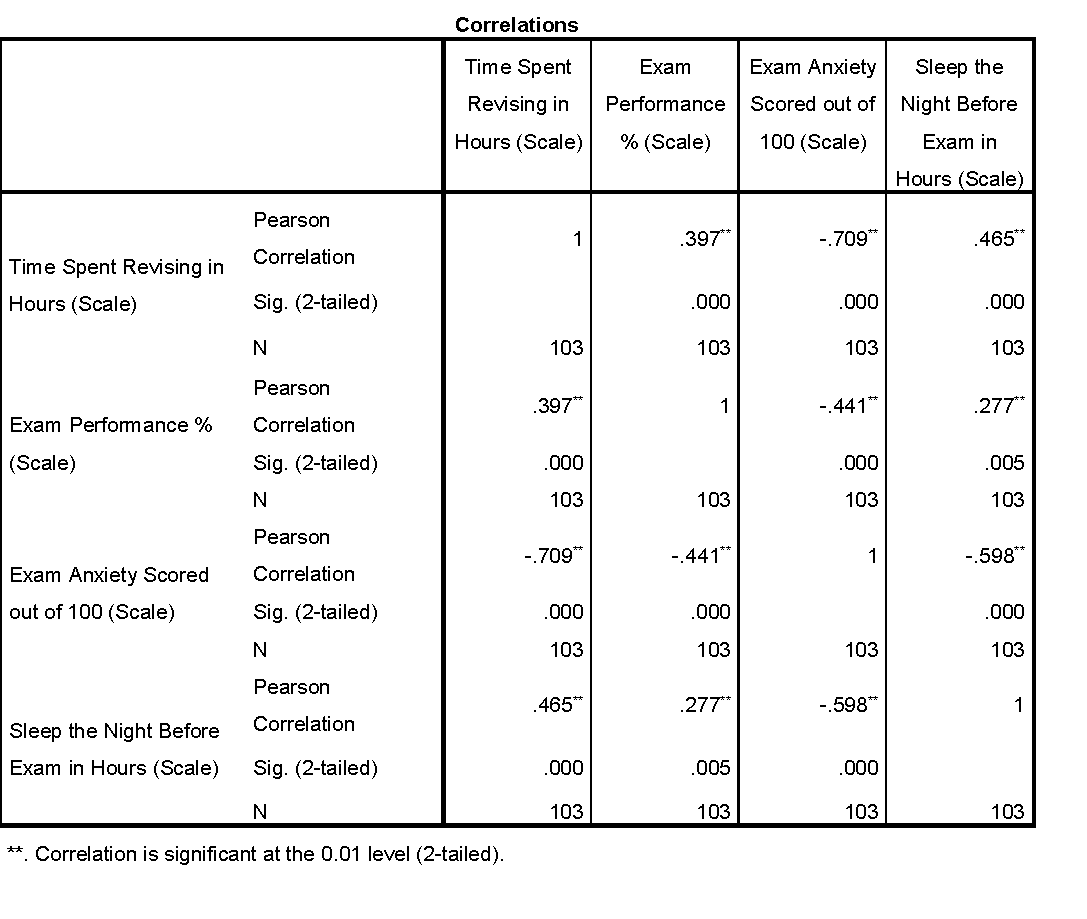
Table 7 above shows a positive correlation between time spent revising and exam performance, r (103) =.397, p <.001. A negative correlation exists between exam performance and exam anxiety, r (103) = -.441, p <.001. There is a positive correlation between exam performance and the number of hours slept the night before the exam, r (103) =.277, p = 0.005.
There is a strong negative correlation between exam anxiety and the number of hours slept the night before the exam, r (103) = -.598, p <.001. This relationship is portrayed in figure 1 below. There is a strong negative correlation between exam anxiety and the number of hours spent revising, r (103) = -.709, p < 0.01. This relationship is shown in figure 2 below.
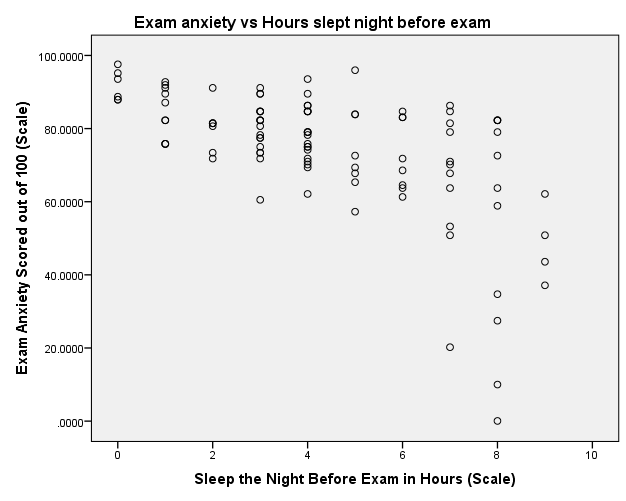
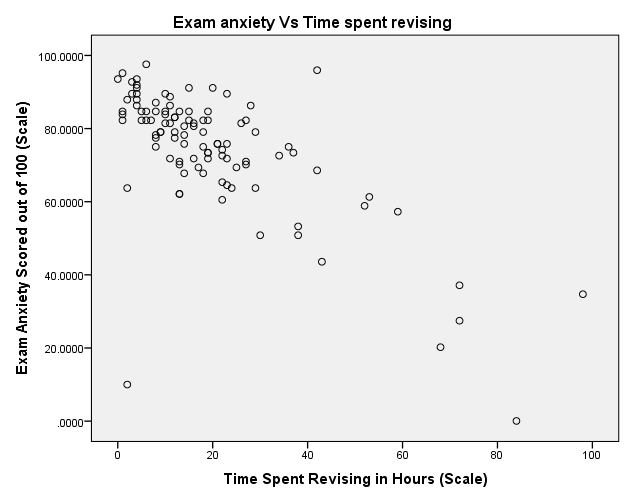
Discussion
From the results above, the hypothesis exam anxiety is not affected by sleep quality, and the number of hours spent revising is rejected because the p-value is less than 0.05. The MANOVA results show that exam anxiety is strongly affected by the number of hours students sleep and the time spent revising.
This implies that it is necessary for the students to set aside enough time for their studies as well as time for sleep to reduce the level of anxiety before exams. The model effectively predicts the relationship between exam anxiety, time spent revising, and the number of hours slept. The R-square value shows that 59.7% of the variation in exam performance and anxiety can be explained by the variation in time spent revising and hours slept.
The independent t-test results are similar to MANOVA findings as it portrays no significant difference between the anxiety level of both the males and the females. The correlation results show that students who spent a significant amount of time revising have a lower anxiety level than those who spend less time. This is portrayed by the positive relationship between the two variables. Exam anxiety and exam performance have a negative correlation as students experiencing high anxiety levels tend to perform poorly.
Furthermore, the students who spend less time sleeping the day before an exam have a high level of anxiety. This is associated with the psychological tiredness that one experiences because of sleeping fewer hours. Exam anxiety and the number of hours spent have a strong negative correlation. This relationship is very strong as a lack of adequate preparedness makes students develop negative emotions regarding exams leading to anxiety.
The limitation of the current study is that it does not involve the measurement of stressors, which may lead to anxiety and lack of sleep leading to exam anxiety. Stressors play a significant role in altering the performance of individuals, making them disoriented. The future study should include more variables and include other measurement instruments, such as Pittsburgh Sleep Quality Index (PSQI). Furthermore, the study should be conducted in stages, increasing the sample size.
Conclusion
The findings of this research study show that Anxiety is significantly determined by the number of hours the students take to prepare for the exam and the number of hours they sleep. The interaction of the two effects shows high anxiety levels. The anxiety levels do not vary with gender, hence the need for interventions that enable students to set aside quality study time and sleep hours. This study provides critical information on the relationship between anxiety and the number of hours of sleep.
References
Campbell, R., Soenens, B., Beyers, W., & Vansteenkiste, M. (2018). University students’ sleep during an exam period: the role of basic psychological needs and stress.Motivation and Emotion, 42(5), 671-681. Web.
Chao, T., & Sung, Y. (2019). An investigation of the reasons for test anxiety, time spent studying, and achievement among adolescents in Taiwan. Asia Pacific Journal of Education, 39(4), 469-484. Web.
Kena, A., & Faustina, A. (2020). Effect of test anxiety and revise time on students’ test performance. Global Scientific Journal, 8(8), 872-894. Web.
Köse, S. (2018). The relationship between exam anxiety levels of senior high school students and sleep quality. Journal of Psychiatric Nursing, 9(2), 105-111. Web.
Yusefzadeh, H., Iranagh, J., & Nabilou, B. (2019). <p>The effect of study preparation on test anxiety and performance: a quasi-experimental study</p>. Advances in Medical Education and Practice, Volume 10, 245-251. Web.

